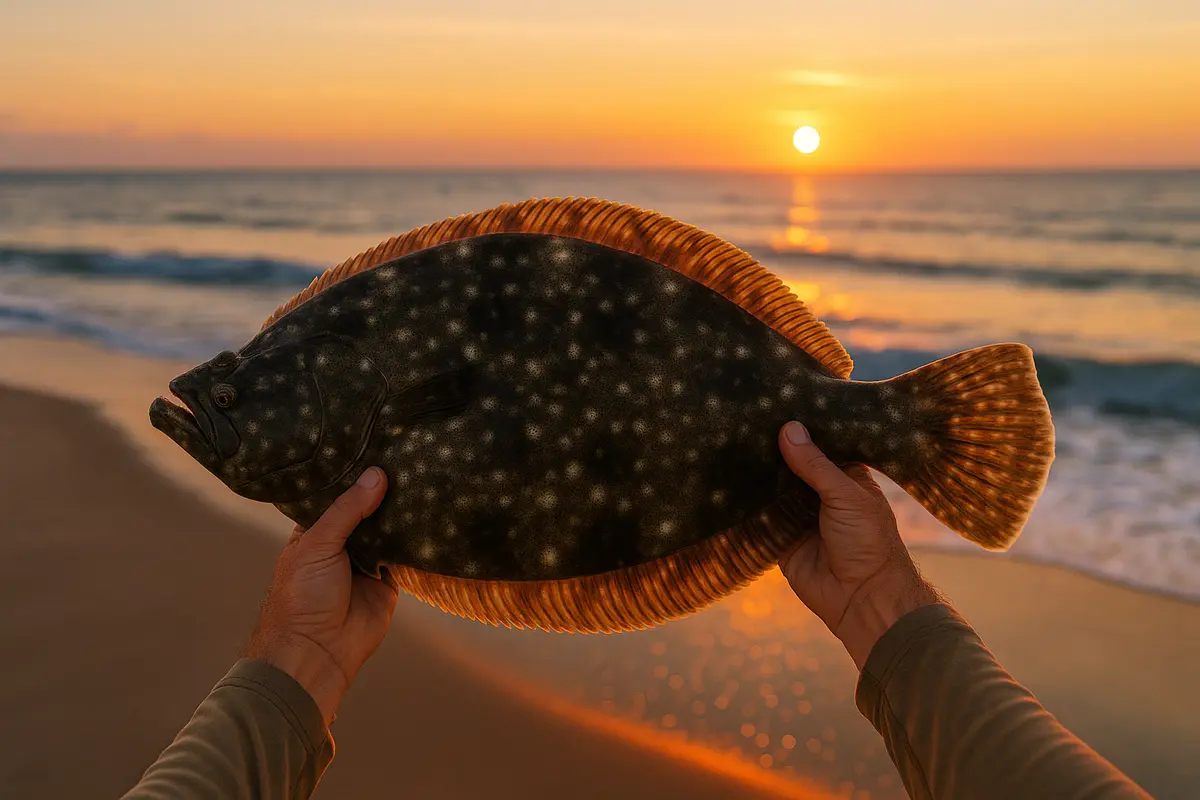Fishing for Flounder in the Surf
Surf Fishing for Flounder

The Complete Guide to Surf Fishing for Flounder
Understanding Flounder Behavior in the Surf
Flounder in the surf are mobile ambush predators that roam troughs, sloughs, and sandbar edges looking for baitfish, shrimp, and sand fleas churned up by wave action. They position on depth changes and current seams, never on featureless bottom. Look for:
- Troughs and sloughs connecting deep and shallow zones
- Sandbar edges where waves break and bait is disoriented
- Holes and depressions that hold current
- Outflows or pilings that concentrate prey
Productive surf flounder zones always have some current and contour—the fish use both to their advantage.
Prime Seasons and Conditions
- Spring (Apr–Jun): Fish push in from offshore; best action as temps hit 60°F+.
- Fall (Sep–Nov): Peak migration and feeding before heading deep.
- Best tides: 2 hours before and after high tide.
- Time of day: Dawn and dusk for the most active bites.
- Ideal surf: 1–3 ft waves with 2–4 ft visibility—slightly stained water helps.
Simple and Effective Rigs
1. Fish-Finder Rig (Standard Surf Setup)
- Sinker: 2–4 oz pyramid
- Leader: 24–36" fluorocarbon (20–25 lb)
- Hook: 1/0–4/0 Kahle or wide gap
- Allows bait to move naturally while holding bottom.
2. Carolina Rig (Calmer Surf)
- Sinker: 1–3 oz egg
- Leader: 30–40" fluorocarbon
- Hook: 1/0–3/0 circle or Kahle
- Great for light surf and sensitive feel.
3. Bucktail Jig (Active Search)
- Weight: 1/2–1 oz
- Colors: White, chartreuse, pink
- Tip with Gulp!, strip bait, or shrimp.
- Slow bounce along bottom—most strikes happen near shore.
Best Baits
Live Baits
- Finger mullet – top producer; hook through lips or behind dorsal.
- Mud minnows – hardy and easy to catch.
- Live shrimp – excellent early or late season.
- Sand fleas – deadly in spring; gather from the wash zone.
Cut and Artificial Baits
- Mullet strips or menhaden chunks – strong scent, stay on hook.
- Gulp! Swimming Mullet – reliable all year.
Productive Techniques
Cast-and-Wait
- Cast into troughs or sloughs and let bait sit.
- Wait 10–15 minutes before moving; scent does the work.
- Use multiple rods at different distances if allowed.
Walk-and-Cast
- Cover ground along the beach, fan-casting each spot.
- Focus on outflows, darker water, or breaking waves over structure.
Bucktail Retrieve
- Let lure hit bottom, then slowly lift and pause.
- Keep contact with sand—flounder strike on the pause.
Reading the Surf
- Low tide: Fish deeper troughs.
- Incoming tide: Flounder push shallow—best window.
- High tide: Peak feeding in 2–5 ft water.
- Falling tide: Productive early phase, then slows.
Best window: 2 hrs before to 1 hr after high tide, especially with early light.
Detecting and Setting the Hook
Bite Feel
- Tap-tap = testing bait
- Heavy weight = flounder holding it
- Slack line = fish swimming toward you
Hook Set
- With J-hooks: reel tight, then sweep firmly.
- With Circle hooks: just reel until tension sets hook.
- Wait 3–5 seconds after first feel before setting.
- Keep steady pressure—flounder have soft mouths.
Quick Tips and Key Takeaways
- Always fish structure and flow, not open sand.
- Dawn/fall tides produce biggest fish.
- Light surf and mild stain = perfect conditions.
- Use pyramid sinkers to hold bottom; adjust with surf strength.
- When unsure, slow down—flounder prefer deliberate movement.
Surf flounder fishing is about patience, reading the water, and staying mobile. Once you find structure and current, you’ve found the fish.
The World's Most Complete Fishing Resource
We're building the ultimate fishing encyclopedia—created by anglers, for anglers. Our articles are created by real experienced fishermen, sometimes using AI-powered research. This helps us try to cover every species, technique, and fishing spot imaginable. While we strive for accuracy, fishing conditions and regulations can change, and some details may become outdated or contain unintentional inaccuracies. AI can sometimes make mistakes with specific details like local access points, parking areas, species distributions, or record sizes.
Spot something off? Whether it's an incorrect boat ramp location, wrong species information, outdated regulations, or any other error, please use the "Help Us Improve This Page" section below. Your local knowledge makes this resource better for every angler.
Explore Related Topics
Discover more articles to deepen your knowledge
Curating articles for you...
Create your own Research Page using AI
Try our AI assistant for free—sign up to access this powerful feature